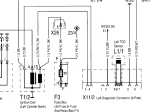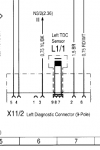So, investigating further my lambda readings on one bank of the M120
Two weeks ago, after gutting the passenger side cat, my lambda went to 50%, and varied a bit, as it should.
Today, noticing a rich exhaust smell, I checked it again. Steady at 70%. No voltage fluctuation. Up on the jackstands it goes again.
Ran a wire from under the hood to the connector for the passenger side 02 sensor. I'm showing continuity between all 4 pins on the 02 harness socket and pin 3 of the X11 connector on the fenderwell. This tells me I have a short somewhere in the harness.
As I don't have wiring diagrams, I'm not sure where to begin. I think I'll replace section of the harness. But with a 4 wire harness, that represents a heated O2 sensor. My new ones are not heated; nor were the old ones.
Where do I start tracing the wires? And can anyone assist me with a wiring diagram? I want to know the interconnections between the X11 diagnostic port, the LH compter harness and the O2 sensor.
Regards
Two weeks ago, after gutting the passenger side cat, my lambda went to 50%, and varied a bit, as it should.
Today, noticing a rich exhaust smell, I checked it again. Steady at 70%. No voltage fluctuation. Up on the jackstands it goes again.
Ran a wire from under the hood to the connector for the passenger side 02 sensor. I'm showing continuity between all 4 pins on the 02 harness socket and pin 3 of the X11 connector on the fenderwell. This tells me I have a short somewhere in the harness.
As I don't have wiring diagrams, I'm not sure where to begin. I think I'll replace section of the harness. But with a 4 wire harness, that represents a heated O2 sensor. My new ones are not heated; nor were the old ones.
Where do I start tracing the wires? And can anyone assist me with a wiring diagram? I want to know the interconnections between the X11 diagnostic port, the LH compter harness and the O2 sensor.
Regards















